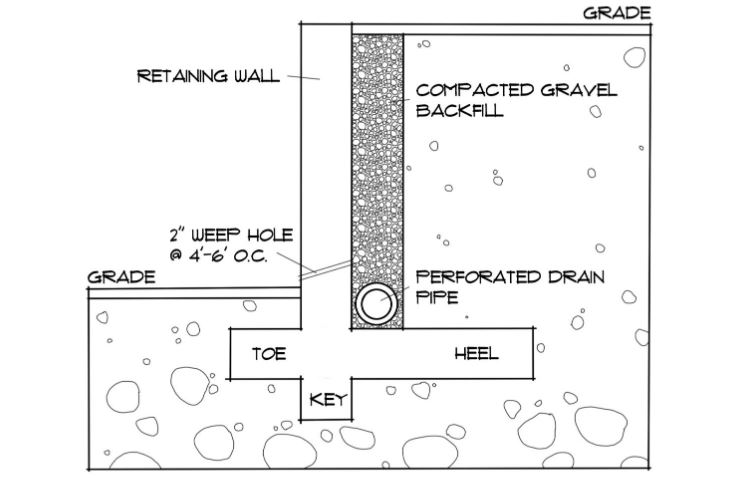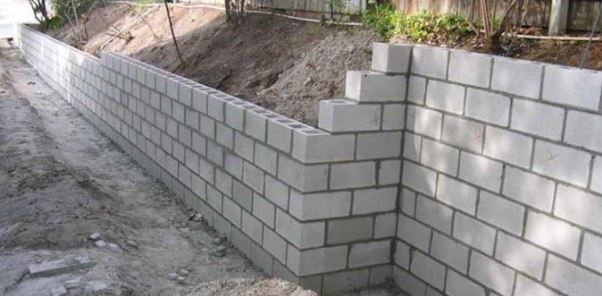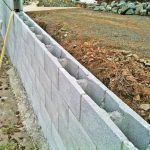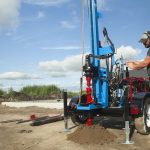A retaining wall footing is an underground concrete structure that provides support to the wall and the soil behind it. In addition, it ensures proper distribution of the weight of the wall as its location is mostly on a slope. In this article, you will learn more about the retaining wall and its footing, the need for its footing, required depth, and design examples.
What is a Retaining Wall Footing?
Retaining walls are structures that prevent soil erosion on sloping areas. Over the years, their use has become more popular and even serve in retaining soil in gardens on level surfaces. Due to loading from the soil and water, a retaining wall often needs a footing or foundation.
The nature of this footing depends on the type of material the wall uses. For example, solid masonry retaining walls such as brick, cinder block, and poured concrete, need a concrete footing. In some building codes, this concrete footing should have rebars for reinforcement. This holds true because, if the footing heaves or shifts, it could damage the wall. When walls are fashioned from paver blocks, compacted gravel may provide the footing.
When Retaining Wall Footing is Needed
When used in a level area, the loading on the retaining wall is not significant. But on elevated or hilly surfaces, the wall encounters more stress, thus it requires a sturdy foundation. Generally, most regions have building codes that point out when footing is required for a retaining wall system. This need hinges on factors such as the soil type, load, and the wall height. Softer soils such as sand and soft clay, reduce the bearing capacity of the wall and increase the likelihood of a footing. Higher walls and loading, the use of a footing becomes imperative.
Also, the water level in the area plays a role in determining the need for a footing. If there are significant amounts on the load-bearing side, it may damage the wall’s stability. As a result, builders always put some type of drainage across the width of the wall, especially if solid. But, if they are stackable retaining block walls with gravel or sand backfills, the water seeps through the backfill.
Depth of Retaining Wall Footing
After marking out the dimensions of the wall, it is time to excavate a trench. The depth of this trench should include the footing and some level of wall embedment. This wall embedment helps to minimize erosion risk and provide additional stability.
Other important parameters are the width of the retaining wall footing and the wall thickness. These three parameters are all related, and as a rule of thumb, the footing thickness should be at least twice that of the wall. The table below highlights a typical relationship between the footing depth (d), footing width (W), and the wall height (H), which includes embedment.
| Wall Height (H) | Footing Width (W) | Footing Depth (d) |
| 0 – 2 ft | 12-in | 4-in |
| 2 – 4 ft | 18-in | 4-in |
| 4 – 6 ft | 24-in | 6-in |
Like the footing depth, the minimum embedment should increase with increasing wall height as the table shows.
| Wall Height (H) | Minimum Embedment |
| 0 – 2 ft | 4-in |
| 2 – 4 ft | 6-in |
| 5 ft | 7-in |
| 6 ft | 8-in |
Generally, following the parameters above provides a suitable design for retaining walls and their footing. However, it is advisable to consult a building engineer when the wall height is greater than 4 ft. Also, when the slope downstream of the wall is greater than the slope upstream, bespoke engineering is necessary.
Design Process
Proper design and construction of a retaining wall and its footing is necessary to avoid failure. Because of poor design, some common deficiencies include:
- Rotation or settlement of the wall or stem due to insufficient footing or stem width, respectively.
- Failure of the stem because of improper placement or selection of steel rebars.
- Use of inappropriate backfill material leading to settlement or failure of the wall.
As a result, the right procedure should be followed to ensure a robust design in the prevailing environmental conditions.
Determine Soil Properties
The first step is determining the soil properties either by referencing building code or undergoing geotechnical investigation. Using geotechnical investigation often provides a less conservative design, thereby leading to cost savings. This investigation is most useful when working with unusual configurations or unfamiliar soils.
Establishing Retaining Wall Geometry
This is the main part of the process because a combination of the soil properties and wall geometry determines if the design is appropriate. The geometry of the wall and footing should ensure stability in the face of service load combinations to prevent the following failure modes:
- Sliding: The resisting force of the wall comes from friction between the soil and footing, as well as passive pressure in the front of the wall. This force should exceed lateral pressure from the backfill by a factor of at least 1.5 to prevent sliding.
- Overturning: The righting moment due to the weight of the retaining wall should be at least twice of the overturning moment from lateral earth pressure.
- Shear: To provide a safe design, the ultimate shear on the wall should be less than the allowable shear. Generally, the design philosophy is to utilize shear keys for higher walls. Lower walls with less loads do not use keys in the footing.

- Bearing pressure: For the footing to be safe, the maximum soil pressure under working load shall be less than the allowable soil bearing capacity. The length of the wall footing is a key parameter in meeting this requirement.




